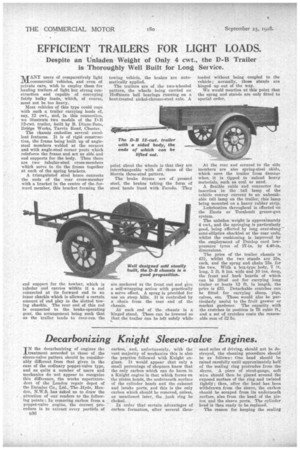Decarbonizing Knight Sleeve-valve Engines.
Page 20

Page 21

If you've noticed an error in this article please click here to report it so we can fix it.
IN the decarbonising of engines the treatment accorded to those of the sleeve-valve pattern should be considerably different from that given in the case of the ordinary poppet-valve type, and as quite a number of users and mechanics do not appear to recognize this difference, the works superintendent of the London repair depot of the Daimler Co., Ltd. The Hyde, Hendon, N.W.D, has asked us to draw the attention of our readers to the following points: In removing carbon from a poppet-valve engine, the correct procedure is to extract every particle of
B36 carbon, and, unfortunately, with the vast majority of mechanics this is also the practice followed with Knight engines. It would appear that only a small percentage of shopmen know that the only carbon which can do harm in a Knight engine is that which forms an the piston heads, the underneath surface of the cylinder heads and the exhaust and intake ports, and this is the only carbon which should be removed, unless, as mentioned later, the junk ring be choked.
In order that certain advantages of carbon formation, after several thou
sand miles of driving, should not be destroyed, the cleaning procedure should be as follows: One head should he raised carefully until approximately half of the sealing ring protrudes from the sleeve. A piece of stout-gauge, soft wire should then be placed around the exposed surface of the ring and twisted tightly ; then, after the head has been withdrawn from the sleeve, the carbon should. be scraped from its underneath surface, also from the head of the piston and the sleeve .ports., The cylinder head is then ready to be replaced.
The reason for keeping the sealing ring compressed should be obvious. Suppose, for instance, that it be allowed to snap open. This breaks the joint of carbon between the ring and its groove ; also, during the process of scraping carbon from the head the ring will probably be turned slightly several times, thus, owing to its irregularity, destroying the surface of the break and making it impossible again to compress the ring sufficiently to place it back in the sleeve. It then becomes necessary to remove the ring and clean the carbon from its inner surface and from its groove. Now comes the objectionable feature, for, with the job finished and the engine started, a very noticeable click will often he heard, and one which was not there before decarbonizing was carried out. This is caused by slackness of the ring in the groove. The click, sinless it be occasioned by a very badly worn ring, can, however, be ignored, as after running some miles the groove will carbon up and the click will pass away.
It is, of course, essential that the junk ring should carry out its work and not be permanently closed by carbon.
Some mechanics, in order to remove the click, hammer up the groove, with the consequence that the ring jams and ceases to function, resulting in loss of compression and burning of the ring.
































